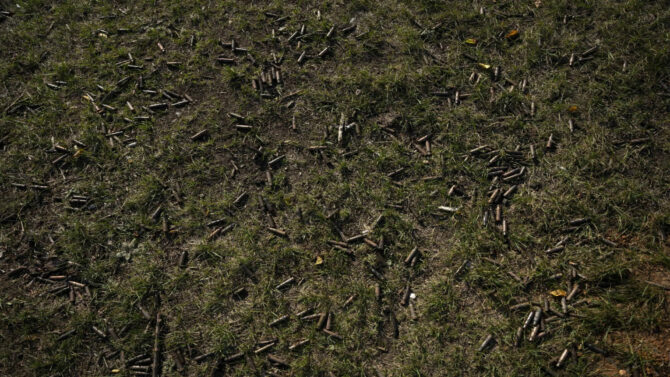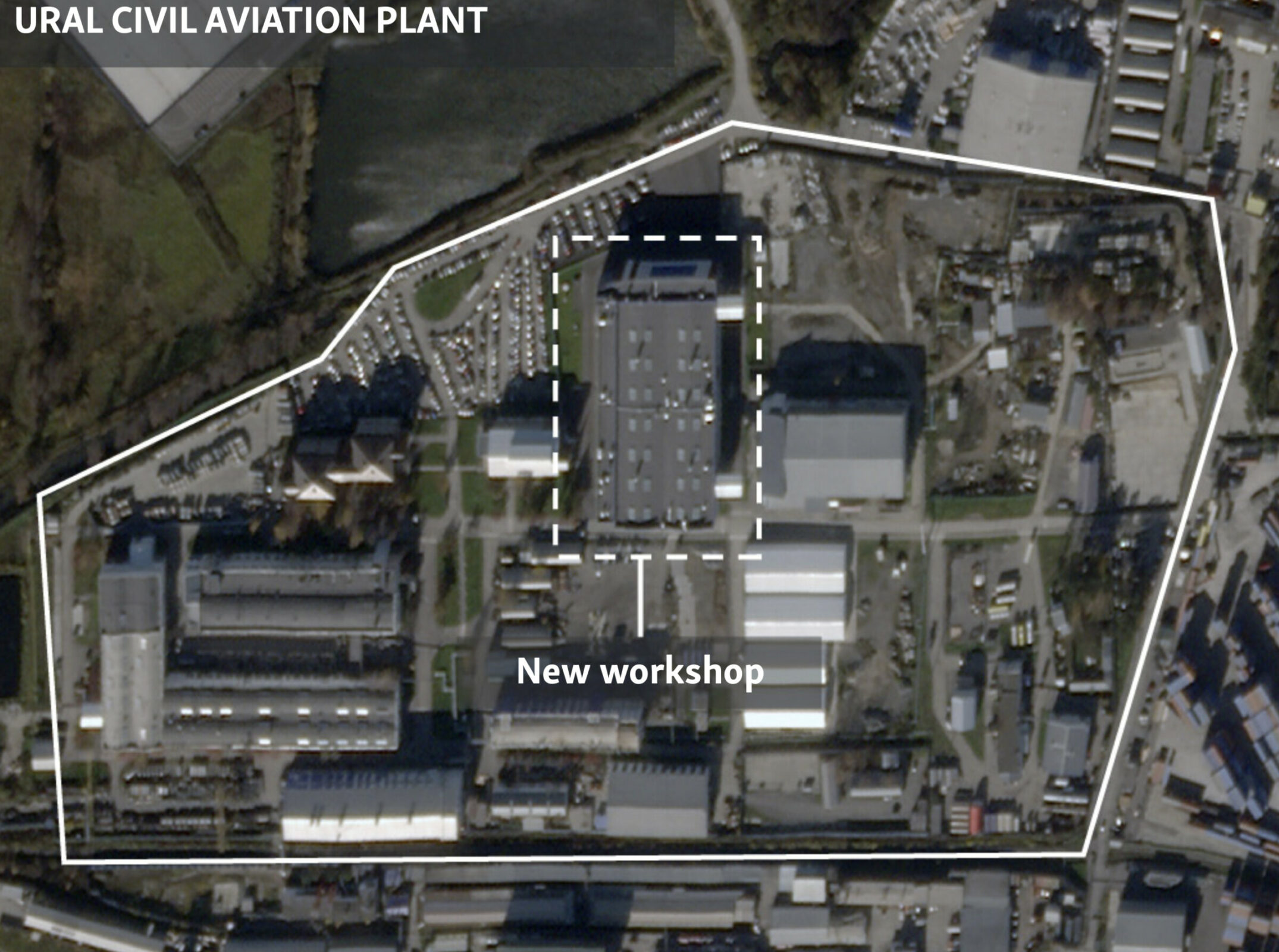This article was originally published by Schemes, program of Radio Free Europe/Radio Liberty, on 1/11/2023 and is hereby reproduced by iMEdD with permission. Any reprint permissions are subject to the original publisher.
An analysis of satellite images by Schemes, RFE/RL’s Ukrainian investigative unit, suggests that Russia is actively building up its capacity for weapons production and developing new factories as its full-scale invasion of Ukraine enters its 21st month with no sign of an end in sight.
From warplanes to combat helicopters to military drones and guided munitions, the facilities are a mix of state-run military factories, public-private partnerships, and civilian-operated dual-use enterprises that manufacture and repair equipment and ammunition for Moscow’s grinding war effort.
In reviewing satellite images provided by Planet Labs, Airbus, and Maxar Technologies, Schemes found several new structures, including hangars and manufacturing plants, that have rapidly expanded or been built from scratch since Russia’s full-scale invasion of Ukraine in February 2022.
In September, the Russian government announced its proposed budget for 2024 and — for the first time in modern history — the country is set to spend 6 percent of gross domestic product (GDP) on its military, with defense spending exceeding social spending.
Mykhaylo Zhyrokhov, a Ukrainian military analyst who authored a book about artillery combat in the war that broke out between Kyiv and Moscow-backed forces in the Donbas in 2014, said the rapid development of such military facilities across the country indicates that the Kremlin has no intention of ending its war against Ukraine anytime soon.
“Russia is preparing to ‘play the long game’ in this war, and is not going to stop anything,” Zhyrokhov told Schemes.
Kazan Aviation Plant
The first facility identified is an aviation plant run by the Russian state military company Rostec that is located near the civilian Borisoglebskoye Airfield in Kazan, some 830 kilometers from Moscow.
Schemes tracked the process of construction of this hangar on the plant’s plot of land with the help of the satellite images. The images indicate that ground was first broken in 2018 but that construction moved slowly until Russia’s full-scale invasion of Ukraine. Work then accelerated, and recent images show that the hangar is nearly complete.

The plant has a long history as a site for repairing civilian and military aircraft and manufacturing parts. The complex was also “one of the most important strategic facilities” in the Soviet era, Anatoliy Khrapchynskiy, an expert on Soviet and Russian aircraft, told Schemes. He said it served as a vital link in the production of military aircraft, particularly bombers, such as the Tu-16, Tu-22, Tu-160, and all of their variations.
In June, the Russian state TV channel Rossia-1 aired a report on the plant, the new hangar, and its history when it was visited by Russian Prime Minister Mikhail Mishustin. The report said that the new hangar is 300 meters long and that the plant is used for the production of the Tu-214, a passenger aircraft.
According to Khrapchynskiy, the plant has always had the capacity to work on strategic aircraft, with many Soviet models still in use by the Russian Air Force. He said the satellite images point to new capabilities in repairing and modernizing older aircraft needed for use in Ukraine, such as the Tu-22M3 and Tu-160.
Ukrainian soldiers divided on fallout of Israel Gaza war

With world attention fixed on the war in Gaza, some Ukrainian soldiers fear Russia could escalate its war.
Irkutsk Aviation Plant
Another state-owned aircraft factory, this aviation plant located in Irkutsk, a city in Siberia roughly 5,000 kilometers from Moscow, appears to be increasing its capacity to produce parts for the Su-30 fighter jet.
The Su-30 is widely used by the Russian Air Force, and the plant in Irkutsk is known as a leading repair site in the country and has been active amid the war in Ukraine.
Satellite images indicate that two new buildings have been constructed recently along with a taxiway that leads to one of them, which resembles a hangar.

Khrapchynskiy, who reviewed the images, said that such facilities are typically used for small aircraft and that the buildings look like the type used “for routine maintenance and minor repairs” for smaller civilian aircraft and military ones like the Su-30.
Ural Civilian Aviation Plant
Although its name says that it deals with civilian aircraft, the facilities are also involved in repairing engines and gearboxes that can also be used in military helicopters such as the Mi-2, Mi-8, Mi-24, and Ka-52. All these helicopters are actively used by the Russian military in the ongoing war in Ukraine.
Production at the plant in the Urals city of Yekaterinburg appears to have been stepped up recently. In September, several local publications based in the area published articles about a shortage of staff at the plant, mentioning that increased production needs have left a personnel shortage.

Satellite images show that construction began on a new workshop structure on the premises in 2021. The building was completed this year following what appears to be faster-paced construction since the war began.
Dubna Machine-Building Plant And Kronstadt
Situated in the city of Dubna, north of Moscow, this plant is operated by Raduga, which is under the umbrella of the Tactical Missile Weapons Corporation, a Russian state-owned defense company specializing in missile production.
This company is responsible for making missiles like the Kh-22, Kh-55, and Kh-101 — all of which Russia has used extensively, including in attacks that have hit energy infrastructure, residential buildings, and other civilian facilities.
Comparison of satellite images of the plant from 2021-23 shows that a large new building has been erected next to the plant, with construction appearing to begin in 2021 and completed this year. Two helipads are also situated nearby and the building shares an access road with the Dubna Machine-Building Plant.

According to public records, the new factory is privately owned by Kronstadt, a company that is involved in the production of unmanned aerial vehicles (UAVs). The company specializes in producing military drones, including the Orion and Helios models that are used for reconnaissance and strikes.
Kronstadt was previously owned by AFK-Sistema, a large Russian conglomerate founded by Vladimir Yevtushenkov, a prominent tycoon. AFK-Sistema sold its stake in Kronstadt in May 2022, around the same time that Yevtushenkov gave up formal shareholder control of the conglomerate by transferring a 10 percent stake to his son after the United Kingdom imposed sanctions over Russia’s war in Ukraine.
According to the Russian register of legal entities, AFK-Systema still holds a 49.6 percent stake in KT-Unmanned Systems, a Kronstadt subsidiary that, according to the company’s website, cooperates with the Russian Defense Ministry and the Federal Security Service.
In June 2022, months into the full-scale invasion, Aleksei Belykh, Kronstadt’s deputy director, said that the company was recruiting staff to run the new facility in Dubna.
“The new plant for the production of [UAVs] will soon switch to three shifts in order to fulfill the orders received. In connection with this, the Kronstadt company continues to recruit personnel,” the Russian military news site Top War reported.
The ‘Italmas’ Plant
In January, it was first reported that drone developer Zala Aero had purchased a shopping center in Izhevsk and converted it into a drone production plant for the Russian-made Italmas drone. In September, Russian President Vladimir Putin made a televised visit to the facility.

Zala Aero is a subsidiary of the Kalashnikov Group, the arms manufacturer that produces 95 percent of Russia’s small arms. The Italmas drones are a new long-range attack UAV that are similar to the Iranian-made Shahed drones that were extensively used on Ukrainian cities last winter, but are lighter and cheaper to manufacture.
The Washington-based Institute for the Study of War has reported that documented Italmas drones are already in use against Ukrainian targets and said that their development is part of a broader Russian strategy to diversify and preserve its munitions as it continues to dig in for a long-running conflict with Ukraine.
Written by Reid Standish based on reporting by Kyrylo Ovsyaniy of Schemes
Copyright (c)2023 RFE/RL, Inc. Used with the permission of Radio Free Europe/Radio Liberty, 1201 Connecticut Ave NW, Ste 400, Washington DC 20036.